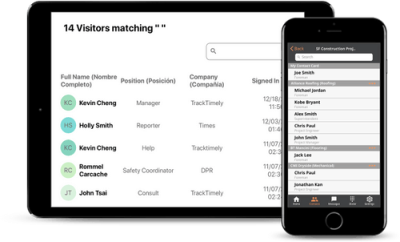Contributed by David Ward, CEO of Safe Site Check In
Digital transformation in the construction industry is inevitable. Investors have poured at least $3B into construction tech over the past few years. Meanwhile, a recent survey by the National Association of Women in Construction (NAWIC) and Safe Site Check In found 95 percent of workers on jobsites report being more productive because they’re using digital tools. Still, a Dodge Construction Network survey found only 15 percent of construction companies have gone forward with their digital transformation strategy. Where’s the disconnect? Three of the biggest holdups in a general contractors (GCs) digital transformation are the perceived time, costs and labor. The irony is digital transformation, by design, addresses those very issues. Starting small is one key to success.
Three Shortcuts to Big Wins
For many GCs, getting started with digital transformation may seem overwhelming. That’s why it’s recommended to follow these three guidelines:
1. Start small to rack up quick wins and prove the ROI. This inspires employees to tackle more complex projects as the business makes its shift to being 100% digital.
2. Don’t buy any digital tools unless they benefit at least 10% of your workforce on the jobsite and in the office. One of the biggest untapped resources is information that’s gathered from the field. After all, that’s where a contractor makes or loses money. What you want to avoid is a collection of on-off digital tools that are used on various job sites based on a project manager’s preferences. This creates information silos. When you can bridge what’s happening on the jobsite with what’s happening in the office and integrate the data sources, you’ll see a faster and larger ROI from the technology.
3. If the digital tool collects or stores data, make sure it’s secure and that data can “speak” to other technologies you’re using. You want to be able to link different sources of data. With labor in short supply, for example, you’ll want a view into the productivity of every activity.
Throughout the process, it’s important to remember that digital transformation is iterative. For a lot of GCs, this is counter-intuitive because they’re used to building, finishing a project, and moving on to the next one. Digital transformation, on the other hand, is an ongoing process of learning. To transform, the use of digital tools becomes part of the business DNA, not an isolated project.
Construction Processes Ripe for Disruption
One of the biggest benefits of digital transformation is the way it can help close the labor shortage gap. In turn, this impacts cost and time issues. It’s no secret that the Associated Builders and Contractors (ABC), an industry association, reported earlier this year the construction industry will need to attract nearly 650,000 additional workers on top of the normal pace of hiring in 2022. While digital transformation can’t create more workers, it can make each one more productive without exhausting them. It does this by reducing admin, streamlining processes, and automating tasks.
For example, a lot of GCs are still using paper and pen for workers to sign in while project managers still handwrite the daily log. At first, these might not seem like time-intensive activities but here’s how and why they can become a huge problem.
Illegible handwriting on sign in sheets, which are also based on the honor system, are often rekeyed into an accounting or payroll system and/or put into a project management platform. This can take up to two hours of admin each day, on average. When it comes to the daily log, this is often one of the last activities before the crew goes home. You can imagine how easy and tempting it would be to create a “good enough” report that also gets filed away and/or input into different systems back in the office. Add in another 1-2 hours for admin.
Now imagine the repercussions of an incident on the jobsite. This can range from a subcontractor getting hurt to a natural disaster. Depending on the issue, OSHA may get involved along with attorneys. A lot of eyes will be on those paper forms to find out who exactly was on the site and when, their responsibilities, skills and experience, job site conditions, and a lot of other information that’s kept on paper, open to interpretation, and handled by several employees.
Digital check in solves these issues. The digital transformation process starts the minute a worker enters a jobsite. The check in screen captures their legible name and start time, directs them to their project, location and supervisor, and creates a profile including their certifications and attendance at safety talks. During the day, project managers can blast a text or email to the crew and upload pictures from the site. At the end of the day, the information gets aggregated to populate the daily log. The time savings can add up to a few hours each day because less time is spent filling out forms, leaving more time to advance the project.
Other ways to score quick wins through low cost digital tools are to look across the company at the activities that cut into profitability and impact several departments. For example, surveying and estimating can be streamlined through digital tools. These areas have been ripe for digital transformation because of the need to eliminate guesstimates, which are costly and time consuming and impact the profitability and timeline of projects. Other tools include GPS Layout, drones, robots, wearables, and augmented reality.
While construction has been slow to embrace digital transformation, the current climate will accelerate the pace, especially as GCs see how digital tools address labor, cost and time issues. Once you demonstrate investments in technology are paying off and employees get more comfortable using them, they will shed old school processes and replace them with faster, digital tools. Before you know it, the digital transformation process will be underway.
 About the Author: David Brian Ward is the CEO and founder of Safe Site Check In. He has more than 30 years of experience as a technology entrepreneur and investor. David’s experience has centered around the business of technology management for organizations ranging in size from Fortune 500 companies to startups in their infancy stages. Prior to Safe Site Check In, Ward was the founder of Telegraph Hill Software, an enterprise technology consulting firm providing leadership and technical expertise in development, engineering, operations, and program management.
About the Author: David Brian Ward is the CEO and founder of Safe Site Check In. He has more than 30 years of experience as a technology entrepreneur and investor. David’s experience has centered around the business of technology management for organizations ranging in size from Fortune 500 companies to startups in their infancy stages. Prior to Safe Site Check In, Ward was the founder of Telegraph Hill Software, an enterprise technology consulting firm providing leadership and technical expertise in development, engineering, operations, and program management.







